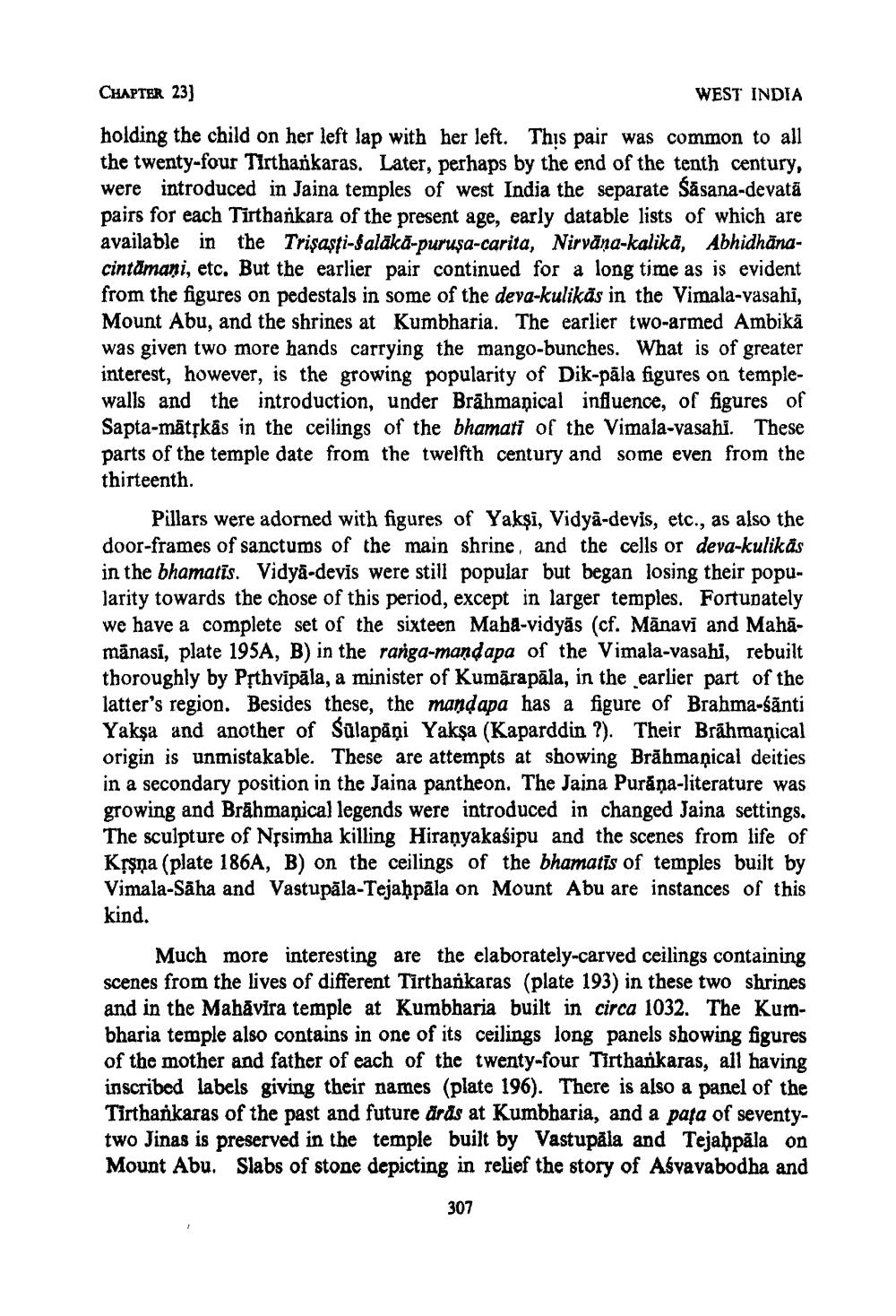________________
CHAPTER 23]
WEST INDIA
holding the child on her left lap with her left. This pair was common to all the twenty-four Tirtharkaras. Later, perhaps by the end of the tenth century, were introduced in Jaina temples of west India the separate Sāsana-devatā pairs for each Tirthařkara of the present age, early datable lists of which are available in the Trişaşți-salākā-puruşa-carita, Nirvana-kalikä, Abhidhānacintamani, etc. But the earlier pair continued for a long time as is evident from the figures on pedestals in some of the deva-kulikās in the Vimala-vasahi, Mount Abu, and the shrines at Kumbharia. The earlier two-armed Ambikā was given two more hands carrying the mango-bunches. What is of greater interest, however, is the growing popularity of Dik-pāla figures on templewalls and the introduction, under Brāhmaṇical influence, of figures of Sapta-mātskås in the ceilings of the bhamati of the Vimala-vasahi. These parts of the temple date from the twelfth century and some even from the thirteenth.
Pillars were adorned with figures of Yaksi, Vidya-devis, etc., as also the door-frames of sanctums of the main shrine, and the cells or deva-kulikās in the bhamatīs. Vidya-devis were still popular but began losing their popularity towards the chose of this period, except in larger temples. Fortunately we have a complete set of the sixteen Maha-vidyās (cf. Mānavi and Mahāmānasi, plate 195A, B) in the ranga-mandapa of the Vimala-vasahi, rebuilt thoroughly by Pșthvipāla, a minister of Kumārapāla, in the earlier part of the latter's region. Besides these, the mandapa has a figure of Brahma-śānti Yaksa and another of Sulapāņi Yakşa (Kaparddin ?). Their Brāhmaṇical origin is unmistakable. These are attempts at showing Brāhmaṇical deities in a secondary position in the Jaina pantheon. The Jaina Purāņa-literature was growing and Brāhmaṇical legends were introduced in changed Jaina sett The sculpture of Nộsimha killing Hiranyakaśipu and the scenes from life of Krşņa (plate 186A, B) on the ceilings of the bhamatis of temples built by Vimala-Säha and Vastupāla-Tejahpāla on Mount Abu are instances of this
kind.
Much more interesting are the elaborately-carved ceilings containing scenes from the lives of different Tirtharkaras (plate 193) in these two shrines and in the Mahavira temple at Kumbharia built in circa 1032. The Kumbharia temple also contains in one of its ceilings long panels showing figures of the mother and father of each of the twenty-four Tirthankaras, all having inscribed labels giving their names (plate 196). There is also a panel of the Tirthankaras of the past and future årds at Kumbharia, and a pața of seventytwo Jinas is preserved in the temple built by Vastupala and Tejabpāla on Mount Abu. Slabs of stone depicting in relief the story of Aśvavabodha and
307




